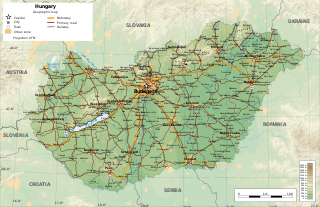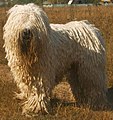
Hungary is a landlocked country in the southeastern region of Central Europe, bordering the Balkans. Situated in the Pannonian Basin, it has a land area of 93,030 square km, measuring about 250 km from north to south and 524 km from east to west. It has 2,106 km of boundaries, shared with Slovakia to the north, Ukraine to the northeast, Romania to the east and southeast, Serbia to the south, Croatia to the southwest, Slovenia to the west and southwest, and Austria to the west.

Hungarian or Magyar cuisine is the cuisine characteristic of the nation of Hungary, and its primary ethnic group, the Magyars. Hungarian cuisine has been described as being the spiciest cuisine in Europe. This can largely be attributed to the use of their piquant native spice, Hungarian paprika, in many of their dishes. A mild version of the spice, Hungarian sweet paprika, is commonly used as an alternative. Traditional Hungarian dishes are primarily based on meats, seasonal vegetables, fruits, bread, and dairy products.

Tripe is a type of edible lining from the stomachs of various farm animals. Most tripe is from cattle, pigs and sheep.

Goulash is a soup or stew of meat and vegetables seasoned with paprika and other spices. Originating in Hungary, goulash is a common meal predominantly eaten in Central Europe but also in other parts of Europe. It is one of the national dishes of Hungary and a symbol of the country.

Polish cuisine is a style of food preparation originating in and widely popular in Poland. Due to Poland's history, Polish cuisine has evolved over the centuries to be very eclectic, and shares many similarities with other national cuisines. Polish cooking in other cultures is often referred to as à la polonaise.

Russian cuisine is a collection of the different dishes and cooking traditions of the Russian people as well as a list of culinary products popular in Russia, with most names being known since pre-Soviet times, coming from all kinds of social circles.

Gulyásleves, is a Hungarian soup, made of beef, vegetables, ground paprika and other spices. It originates from a dish cooked by the cattlemen, who tended their herds in the Great Hungarian Plain. These Hungarian cowboys often camped out with their cattle days away from populated areas, so they had to make their food from ingredients they could carry with themselves, and this food had to be cooked in the one available portable cauldron over an open fire.

Hungarian culture is characterised by its distinctive cuisine, folk traditions, poetry, theatre, religious customs, music and traditional embroidered garments. Hungarian folklore traditions include tales, music, dance, decorated pottery, carvings and embroidery. Historically, Hungarian music has largely consisted of folk music and classical and baroque pieces. Hungary is at the south-eastern border of Central Europe and shares some cultural similarities with countries in the Balkans. Noted Hungarian authors include Sándor Márai, Imre Kertész, Péter Esterházy, Magda Szabó and János Kodolányi. Imre Kertész is particularly noteworthy for having won the Nobel Prize in Literature in 2002.
Romanian cuisine is a diverse blend of different dishes from several traditions with which it has come into contact, but it also maintains its own character. It has been mainly influenced by Turkish and a series of European cuisines in particular from the Balkan Peninsula, or Hungarian cuisine as well as culinary elements stemming from the cuisines of Central Europe.

Tripe soup or tripe stew is a soup or stew made with tripe. It is widely considered to be a hangover remedy.

Pörkölt is a meat stew which originates from Hungary, but is eaten throughout Central Europe.

Czech cuisine has both influenced and been influenced by the cuisines of surrounding countries and nations. Many of the cakes and pastries that are popular in Central Europe originated within the Czech lands. Contemporary Czech cuisine is more meat-based than in previous periods; the current abundance of farmable meat has enriched its presence in regional cuisine. Traditionally, meat has been reserved for once-weekly consumption, typically on weekends.

Bosnian cuisine is the traditional cuisine of Bosnia and Herzegovina. It is influenced by Ottoman, Austro-Hungarian and Balkan cuisines.

Hungarian sausages are sausages found in the cuisine of Hungary. Hungary produces a vast number of sui sausage types. They may be boiled, fresh or dried, and smoked, with different spices and flavors, "hot" or "mild". Many were influenced by their neighbors and brethren.

Chicken paprikash or paprika chicken is a popular dish of Hungarian origin and one of the most famous variations on the paprikás preparations common to Hungarian tables. The name is derived from paprika, a spice commonly used in the country’s cuisine. The meat is typically simmered for an extended period in a sauce that begins with a roux infused with paprika.

The cuisine of Algeria is influenced by Algeria's interactions and exchanges with other cultures and nations over the centuries. It is based on both land and sea products. Conquests or demographic movement towards the Algerian territory were two of the main factors of exchanges between the different peoples and cultures. The Algerian cuisine is a mix of Arab, Berber, Turkish and European roots.

Paprika is a spice made from dried and ground red peppers. It is traditionally made from Capsicum annuum varietals in the Longum group, including chili peppers. Paprika can have varying levels of heat, but the chili peppers used for hot paprika tend to be milder and have thinner flesh than those used to produce chili powder. In some languages, but not English, the word paprika also refers to the plant and the fruit from which the spice is made, as well as to peppers in the Grossum group.

A stew is a combination of solid food ingredients that have been cooked in liquid and served in the resultant gravy. Ingredients can include any combination of vegetables and may include meat, especially tougher cuts of meats suitable for slow-cooking, such as beef, pork, venison, rabbit, lamb, poultry, sausages, and seafood. While water can be used as the stew-cooking liquid, stock is also common. A small amount of red wine, white wine or other alcohol is sometimes added for increased flavour. Seasonings in the form of bouillon cubes or spices and flavourings may also be added. Stews are typically cooked at a relatively low temperature, allowing flavours to mingle for longer periods of time depending on the protein used.


















































